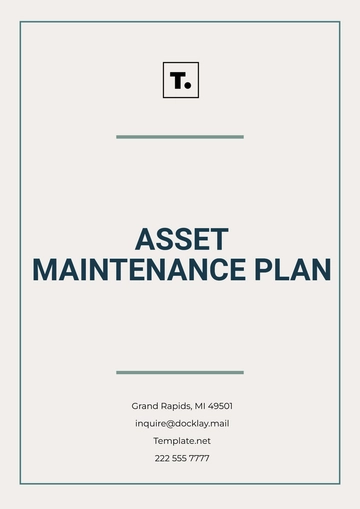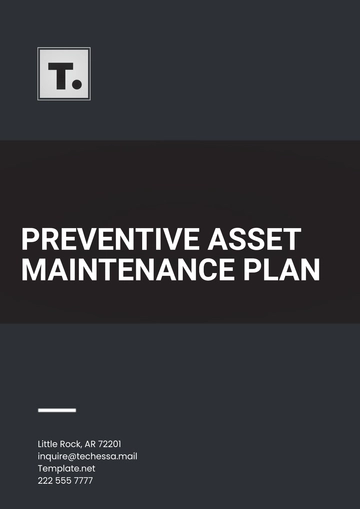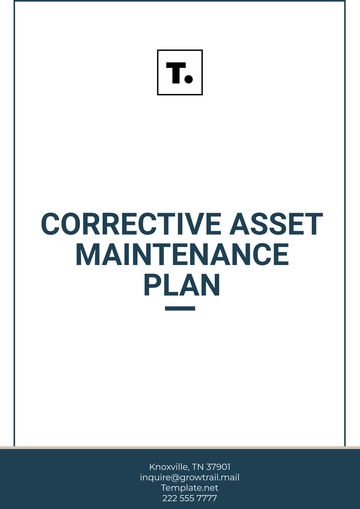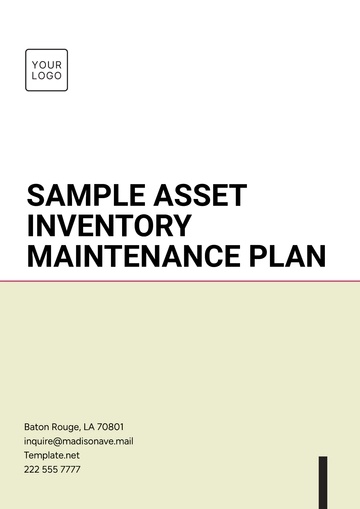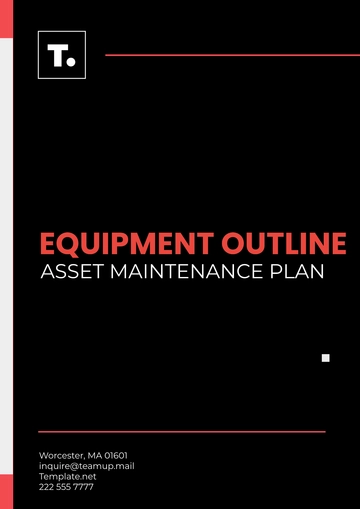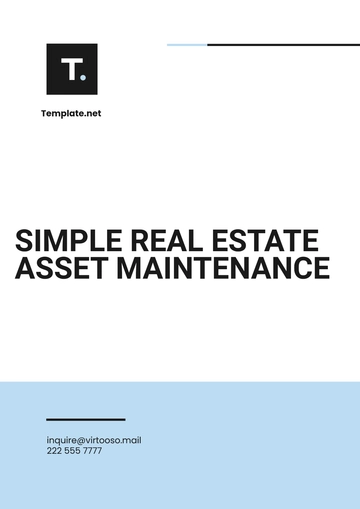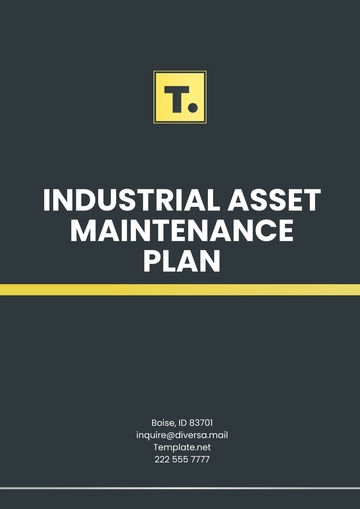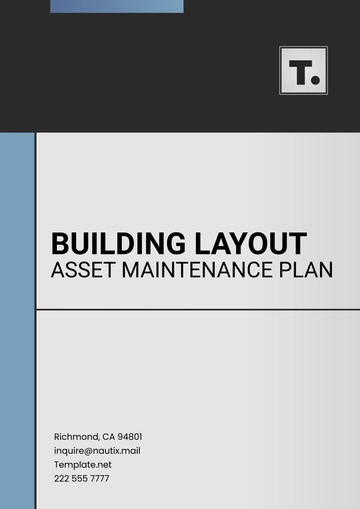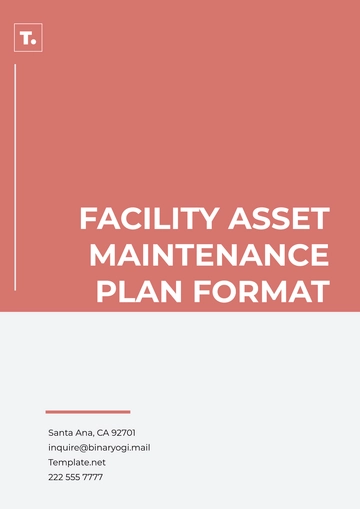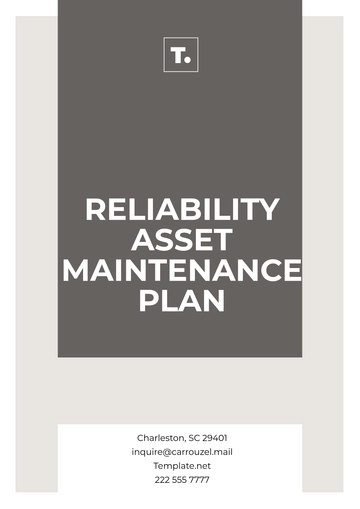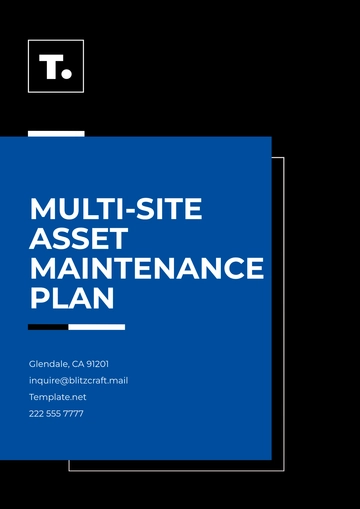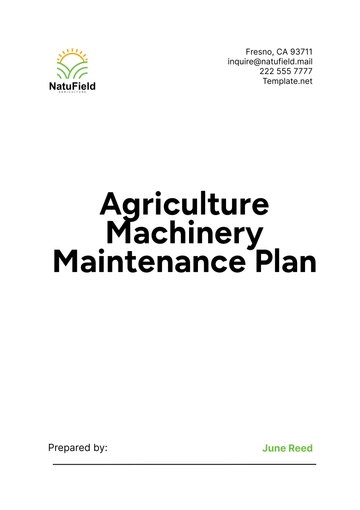Free Reliability Asset Maintenance Plan
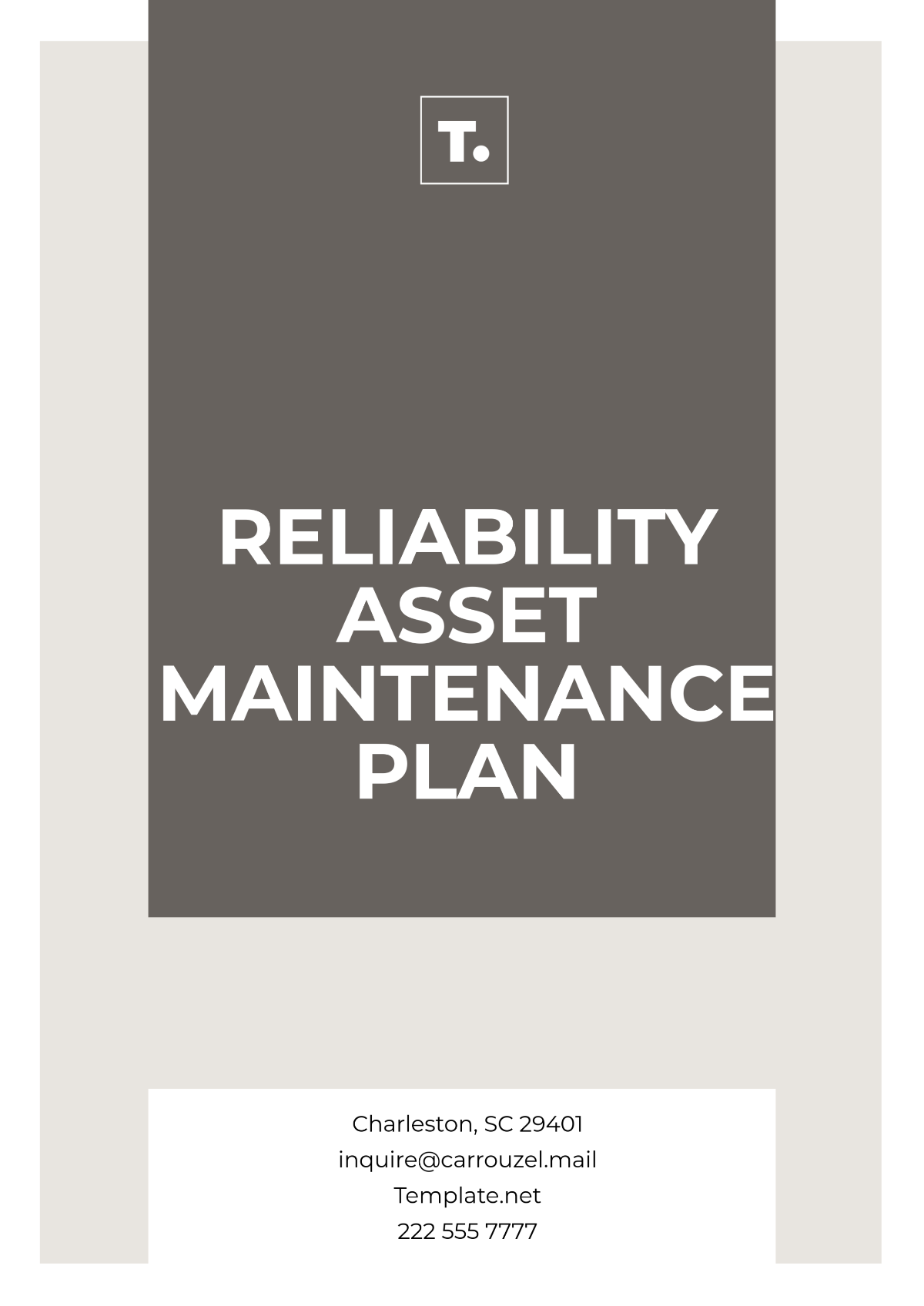
Prepared by: [Your Name]
Company: [Your Company Name]
Date: [Date]
I. Executive Summary
The Reliability Asset Maintenance Plan outlines the strategies, schedules, and processes required to ensure that all assets within the organization operate efficiently and reliably. The primary objective is to minimize downtime, optimize asset performance, and extend the lifespan of equipment through preventive and predictive maintenance practices. This plan aims to provide a structured approach to asset management, support operational goals, and enhance overall productivity.
II. Asset Inventory
The Asset Inventory section lists all assets covered under this maintenance plan, providing details on their specifications and operational importance.
Asset Details
Asset ID: Unique identifier for each asset
Asset Name: Description or common name of the asset
Location: Physical location of the asset within the facility
Type/Category: Classification of the asset (e.g., machinery, HVAC systems)
Age and Condition: Date of purchase and current condition assessment
III. Maintenance Strategy
The Maintenance Strategy defines the specific approaches to maintaining the assets, focusing on preventive, predictive, and corrective measures.
A. Preventive Maintenance
Routine Inspections: Regular checks and services to identify potential issues early
Scheduled Servicing: Timely replacement of parts and lubrication to avoid breakdowns
B. Predictive Maintenance
Condition Monitoring: Using sensors and data analytics to predict equipment failures
Performance Analysis: Evaluating trends in performance data to schedule maintenance before issues arise
C. Corrective Maintenance
Failure Response: Immediate repairs conducted after an asset failure
Root Cause Analysis: Investigating the cause of failures to prevent recurrence
IV. Risk Assessment
The Risk Assessment evaluates the potential risks that could affect asset reliability and outlines mitigation strategies.
A. Risk Identification
Equipment Failure: Risk of unexpected asset breakdowns
Operational Delays: Impact on production due to asset unavailability
B. Risk Mitigation
Backup Systems: Having standby equipment available to minimize disruptions
Training Programs: Ensuring staff are trained in emergency maintenance procedures
V. Maintenance Schedule
The Maintenance Schedule provides a timeline for all planned maintenance activities, including frequency and assigned personnel.
A. Weekly Maintenance
Visual Inspections: Checking for signs of wear or damage
Basic Servicing: Lubrication and minor adjustments
B. Monthly Maintenance
Performance Testing: Running tests to assess asset efficiency
Component Replacement: Replacing parts nearing the end of their life cycle
C. Annual Maintenance
Comprehensive Overhaul: Detailed inspection and refurbishment of major components
Safety Compliance Check: Ensuring assets meet regulatory and safety standards
VI. Roles and Responsibilities
The Roles and Responsibilities section defines the duties of team members involved in the maintenance process.
A. Maintenance Manager
Oversight: Supervises all maintenance activities and ensures adherence to the plan
Reporting: Provides updates on maintenance status and performance metrics
B. Reliability Engineer
Strategy Development: Design preventive and predictive maintenance programs
Data Analysis: Monitors asset performance data and suggests improvements
C. Maintenance Technicians
Execution: Performs scheduled maintenance tasks and emergency repairs
Documentation: Records all maintenance activities and findings
VII. Key Performance Indicators (KPIs)
The KPIs measure the effectiveness of the maintenance plan and help track asset performance.
Common KPIs
Mean Time Between Failures (MTBF): Average time between equipment failures
Mean Time to Repair (MTTR): Average time taken to repair a failed asset
Asset Uptime Percentage: Ratio of time the asset is operational versus downtime
Maintenance Cost per Asset: Total maintenance expenses divided by the number of assets
VIII. Budget and Resources
The Budget and Resources section outlines the financial and resource allocation for the maintenance plan.
A. Budget Allocation
Preventive Maintenance Costs: Funds for routine inspections and servicing
Predictive Maintenance Investments: Expenses for sensors, software, and monitoring tools
Corrective Maintenance Fund: Reserve for emergency repairs and replacements
B. Resource Requirements
Staffing: Number of technicians and engineers needed
Equipment and Tools: List of necessary tools and spare parts
IX. Continuous Improvement Plan
The Continuous Improvement Plan focuses on reviewing and refining maintenance practices to enhance asset reliability.
A. Feedback Mechanism
Regular Reviews: Quarterly meetings to assess maintenance performance
Staff Input: Collecting suggestions from technicians for process improvements
B. Plan Updates
Data-Driven Adjustments: Using KPI analysis to refine maintenance strategies
Adopting New Technologies: Implementing advanced tools or methods as they become available
- 100% Customizable, free editor
- Access 1 Million+ Templates, photo’s & graphics
- Download or share as a template
- Click and replace photos, graphics, text, backgrounds
- Resize, crop, AI write & more
- Access advanced editor
Enhance asset reliability with the Reliability Asset Maintenance Plan Template from Template.net. This customizable and editable template focuses on proactive maintenance to ensure asset dependability. Easily editable in our Ai Editor Tool, it can be tailored to meet your specific reliability objectives and operational needs, making it a valuable resource for streamlined asset management and consistent performance.
You may also like
- Finance Plan
- Construction Plan
- Sales Plan
- Development Plan
- Career Plan
- Budget Plan
- HR Plan
- Education Plan
- Transition Plan
- Work Plan
- Training Plan
- Communication Plan
- Operation Plan
- Health And Safety Plan
- Strategy Plan
- Professional Development Plan
- Advertising Plan
- Risk Management Plan
- Restaurant Plan
- School Plan
- Nursing Home Patient Care Plan
- Nursing Care Plan
- Plan Event
- Startup Plan
- Social Media Plan
- Staffing Plan
- Annual Plan
- Content Plan
- Payment Plan
- Implementation Plan
- Hotel Plan
- Workout Plan
- Accounting Plan
- Campaign Plan
- Essay Plan
- 30 60 90 Day Plan
- Research Plan
- Recruitment Plan
- 90 Day Plan
- Quarterly Plan
- Emergency Plan
- 5 Year Plan
- Gym Plan
- Personal Plan
- IT and Software Plan
- Treatment Plan
- Real Estate Plan
- Law Firm Plan
- Healthcare Plan
- Improvement Plan
- Media Plan
- 5 Year Business Plan
- Learning Plan
- Marketing Campaign Plan
- Travel Agency Plan
- Cleaning Services Plan
- Interior Design Plan
- Performance Plan
- PR Plan
- Birth Plan
- Life Plan
- SEO Plan
- Disaster Recovery Plan
- Continuity Plan
- Launch Plan
- Legal Plan
- Behavior Plan
- Performance Improvement Plan
- Salon Plan
- Security Plan
- Security Management Plan
- Employee Development Plan
- Quality Plan
- Service Improvement Plan
- Growth Plan
- Incident Response Plan
- Basketball Plan
- Emergency Action Plan
- Product Launch Plan
- Spa Plan
- Employee Training Plan
- Data Analysis Plan
- Employee Action Plan
- Territory Plan
- Audit Plan
- Classroom Plan
- Activity Plan
- Parenting Plan
- Care Plan
- Project Execution Plan
- Exercise Plan
- Internship Plan
- Software Development Plan
- Continuous Improvement Plan
- Leave Plan
- 90 Day Sales Plan
- Advertising Agency Plan
- Employee Transition Plan
- Smart Action Plan
- Workplace Safety Plan
- Behavior Change Plan
- Contingency Plan
- Continuity of Operations Plan
- Health Plan
- Quality Control Plan
- Self Plan
- Sports Development Plan
- Change Management Plan
- Ecommerce Plan
- Personal Financial Plan
- Process Improvement Plan
- 30-60-90 Day Sales Plan
- Crisis Management Plan
- Engagement Plan
- Execution Plan
- Pandemic Plan
- Quality Assurance Plan
- Service Continuity Plan
- Agile Project Plan
- Fundraising Plan
- Job Transition Plan
- Asset Maintenance Plan
- Maintenance Plan
- Software Test Plan
- Staff Training and Development Plan
- 3 Year Plan
- Brand Activation Plan
- Release Plan
- Resource Plan
- Risk Mitigation Plan
- Teacher Plan
- 30 60 90 Day Plan for New Manager
- Food Safety Plan
- Food Truck Plan
- Hiring Plan
- Quality Management Plan
- Wellness Plan
- Behavior Intervention Plan
- Bonus Plan
- Investment Plan
- Maternity Leave Plan
- Pandemic Response Plan
- Succession Planning
- Coaching Plan
- Configuration Management Plan
- Remote Work Plan
- Self Care Plan
- Teaching Plan
- 100-Day Plan
- HACCP Plan
- Student Plan
- Sustainability Plan
- 30 60 90 Day Plan for Interview
- Access Plan
- Site Specific Safety Plan
